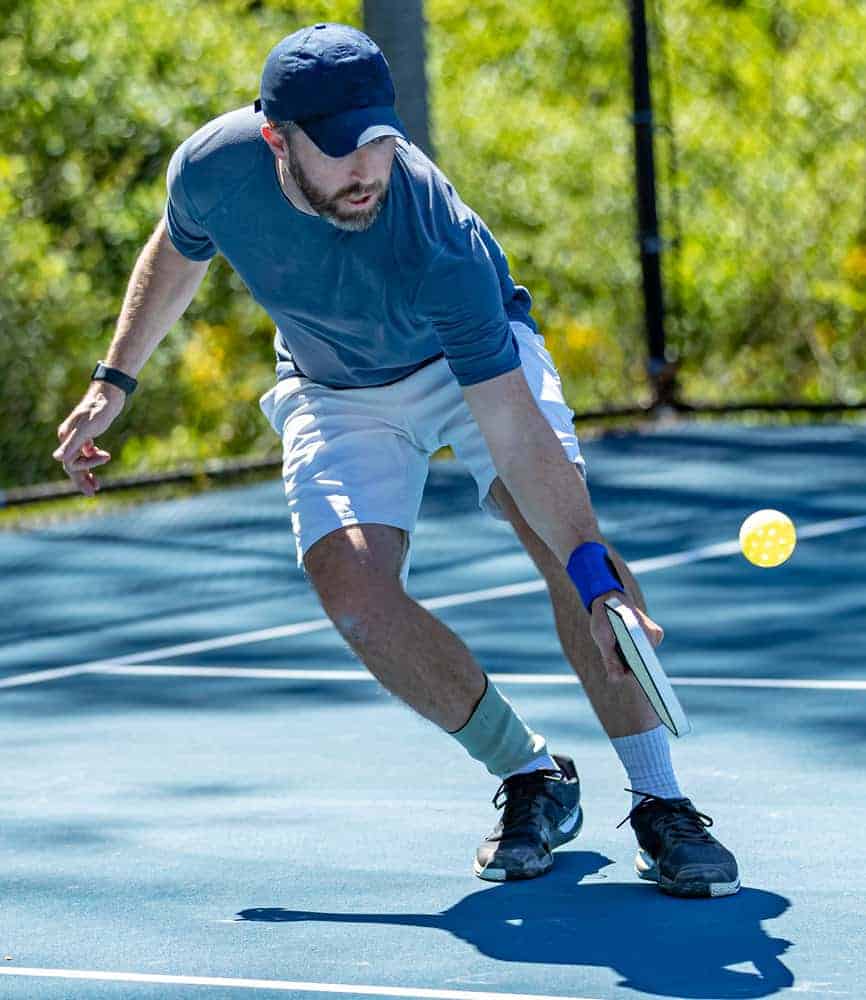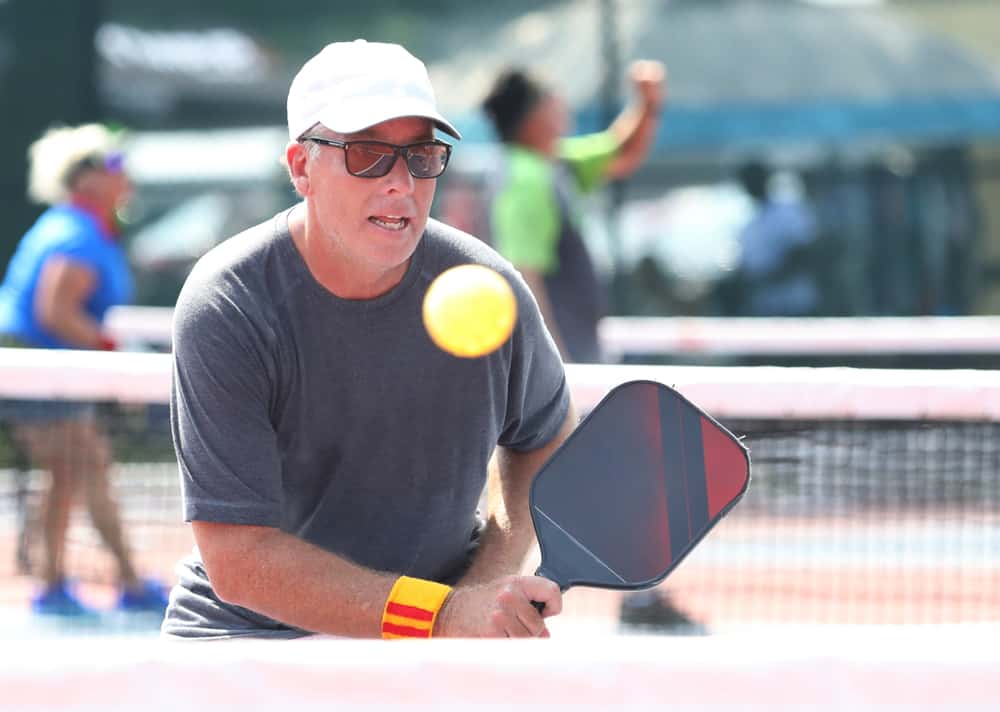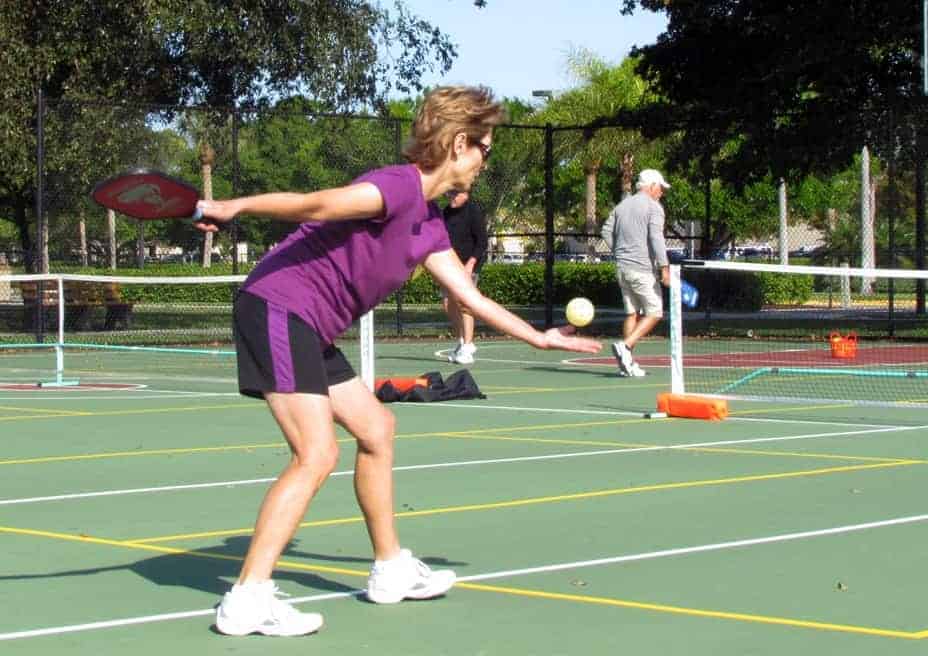In this post, we’re going to talk about an aspect of the game of pickleball that plagues beginners and experts alike. Whether you’re still learning pickleball or competing in tournaments – unforced errors in pickleball can really impact the match
What is an unforced error in pickleball?
An unforced error in pickleball is when a player makes a mistake or commits a fault on a returnable shot—for instance, simply hitting the ball into the net on an easy return shot. Unforced errors are when your opponent wins a point because you made a mistake.
Reducing your unforced errors in pickleball is a fundamental strategy that will allow you to win more games.
It is “unforced” because your opponent has done nothing to win the point. You did it for them. Unforced errors hand the point to your opponent. Essentially, you’ve gift-wrapped the point for them.
The most common unforced error in pickleball is hitting the serve into the net. When this happens, your opponent didn’t do anything to earn the point. You gave it to them unforced.
These are the best points if you’re on the receiving end and the worst points if you’re the one causing them. But, there is hope…
This paddle is the most forgiving paddle I've ever played with and has a HUGE sweet spot!
Why Are Unforced Errors in Pickleball So Important?
Keep in mind that most points are lost by hitting the ball in the net or out of bounds, rather than the result of an outright winner. One of the fundamental strategies in pickleball is to keep the ball in play.
Good players always give their opponents a chance to mess up. When in doubt, hit it under control down the middle. Playing it safe isn’t going to win you any style points but, it’s going to win you actual points. Those are the ones that matter.
My biggest pet peeve in pickeball also happens to be an unforced error. It’s when the serve doesn’t land in bounds. This is an easy example of an unforced error that ended the point without your opponent having to work for it.
Related: I interviewed 3 5.0 level Pros and the owner of Pro-Lite Sports – what I learned about pickleball paddles will shock you!
I’ve heard 5.0 Pro Teammates Dave Weinbach and Kyle Yates talk about their strategy. They each talk about consistency and keeping the ball alive.
Kyle always says they try to outlast their opponents. You can outlast your opponents if you don’t beat yourself. At the heart of this mindset is eliminating unforced errors.
Another strategy Kyle mentions is trying to keep the ball down. That means their shots are not easily teed up on and smashed back in their direction. They force their opponent to hit low to high, teeing up shots for Kyle and Dave to put away.
To top it off, Dave openly says the game is about consistency and they win a lot of tournaments because they just don’t make a lot of unforced errors.
Here is a humble pro player breaking the game of pickleball down into its simplest form. I love it!

Pickleball Unforced Errors – A Mental Game Within The Game
It can be very helpful to evaluate your unforced errors. Learn from “what happened” when you miss a serve, return, groundstroke, volley, or dink.
When you evaluate your shot (or anything else for that matter), remember that the brain learns from a “positive statement” of what to do. For example, when you hit a serve or return into the net (or out), tell yourself what the correct thing is to do. For example, hitting the ball smoothly a foot or so above the net and near the baseline.
Simple, reinforced instructions bring your brain back to the fundamentals. If you’re like me, you have to continually pound that back into your brain. After trying too hard to get fancy on a serve, I’ve been known to audibly tell myself in a calm yet firm voice “Keep it safe, go deep and center.”
These small self-reminders can help keep the mental side of the game in check, and reduce your unforced errors.
Have you ever hit a bad shot and asked yourself “What are you doing?”
Negative self-feedback exists too, and it can be destructive. Be careful with how you’re correcting yourself mentally. Negative words can have a negative effect.
For instance, when you say “Don’t hit it into the net” research shows that the brain sees and hears the verb (HIT) and the noun (NET). It misses the negative (DON’T). Parents make this mistake all the time, myself included – it is better to tell your kids to close the door softly, rather than don’t slam the door.
The brain hears “slam” and “door.” The more you think about it, the more examples you’ll find where you’re making this simple but preventable mistake. Now that you’ve got it on your radar, you have a huge advantage and change the way to speak to yourself (and others).
This can help reduce unforced errors big time! It is also very important to learn to accept the outcome of each shot and be as non-judgmental as possible. Like in golf, there are no bad shots.
There are pure shots and topped shots (insert your favorite miss) but they are all just shots with certain characteristics. You will play and enjoy pickleball (and golf, or whatever) more when you don’t add “value” or judgment to the outcome, shot, or play.
Learn from your mistakes, enjoy the activity; and don’t be that jerk or psychopath screaming at yourself on the court. Be humble in your good shots, learn from every shot (good or not so-good), and move on.

The point is, that negative words can produce negative feedback and negative results. Positive words are more likely to yield positive feedback and positive results.
Sometimes the simple things are also the hardest things to implement.
How To Avoid Unforced Errors in Pickleball
Your brain will try to help you hit your target, and you can be as general or specific as you want. Here is an example we use all the time – “Aim small, miss small” means to have as tiny a target as your skill allows.
Positive intention will help with all of your shots. Before serving try this.
Walk yourself through HOW you’re going to serve it and WHERE it’s going to go like this – “the serve goes over the net by one to three feet, and lands near the baseline and toward my opponent’s backhand.”
Your brain has been told the instructions and now your body is ready to execute. Give it a shot, no pun intended!
The return and groundstrokes have pretty much the same intention. Learn and practice the basics on all of your shots, briefly walk yourself through the process mentally, and soon you will be playing better.
The more you do this, placement and control will become high priorities for you, and will lead to shots that eliminate unforced errors, keeping the ball in play, and allowing your opponent to make the mistakes.
What is the Difference Between a Forced Error and an Unforced Error?
The difference between an unforced error and a forced error in pickleball comes down to how the error was committed. An unforced error means you committed the fault on your own while a forced error means your opponent made you commit the fault.
For example, if you simply hit the ball into the net and your opponent had nothing to do with it, that’s an unforced error. However, if your opponent hits a great shot at your feet, and it forces you to get out of position and subsequently hit it out, that’s a forced error.
Forced errors in pickleball are great shots from your opponent that put you in a bad spot. Unforced errors are errors committed by you where you’re 100% responsible for the mistake.
Pickleball Unforced Errors – The Fundamentals

Like shot selection and shot execution, footwork is very important. Read your opponents paddle, and get into position early, and bend your knees. Make a smooth swing and strike the ball in front of you.
Remember the three “P”s.
Preparation … anticipate where the ball will land, get into position early with a smooth swing.
Placement … hit the ball above the net, and in-bounds.
Pace..keep the ball in play at all times.
These are three things beginners and experts alike try to implement every time they step on the court.
Unforced Errors and Shot Basics
The Serve – You should never miss a serve. 4.0 and above rarely miss a serve, the understand the value of consistency. Practice getting all your serves in with proper pace and placement.

The Return – You should never miss a return. Practice hitting your return with proper placement and pace. This really sets up the whole point. text here…
The Third Shot – This is the key shot in pickleball. Practice your third shot drop (lands in the kitchen), and third shot drive (usually hit hard and down the middle).
The Dink – Dink shots should arc the highest on your side of the net and come down softly in the kitchen. This takes practice. Don’t focus on trying to skim the ball over the net. It’s about arc and where the ball lands in your opponent’s no-volley zone.
The Lob – Lobs should be high and deep, creating a difficult return for your opponent and increasing their unforced error opportunity.
How Many Unforced Errors Are There in Pickleball?
Generally speaking, there are 7 unique unforced errors in pickleball that we can safely categorize into 7 buckets. They are: Hitting the ball out, hitting the ball into the net, service line foot faults, kitchen line foot faults, violating the Two-Bounce rule, illegal serves and volleying in the kitchen.
Let’s take a closer look at each one.
1. Hitting the Ball Out
This is as straightforward as it sounds. It doesn’t matter what is going on in the middle of a point, if you hit the ball out of bounds, that is an unforced error.
2 Hitting into the Net
This one is also very simple. If you hit the ball into the net at any point, it’s an unforced error giving you opponent the point based on your mistake, I see beginners commit this unforced error during serves all the time.
3. Service Line Foot Faults
A service line foot fault is an unforced error where your foot is touching the baseline while serving. You must have both feet behind the baseline before making contact with the ball, otherwise, it’s a fault, the serve is lost and your opponent benefits without having to lift a finger.
4. Kitchen Line Foot Faults
This error happens when you hit a volley out of the air and your momentum carries you into the kitchen area. Regardless of if your shot is in or not, if you cross the kitchen line, you’ve committed an unforced error. Your shot could have even won the point, but if you’ve crossed the kitchen line in the process, it won’t count and the point is lost.
5. Two-Bounce Rule Violation
In pickleball the ball must be allowed to bounce twice before any volley can occur. So if you’re the server, you must allow the return of serve to bounce before hitting it. Otherwise, that is considered a violation of the two-bounce rule and an unforced error.
6. Illegal Serves
This is another common sense type of fault. If you don’t serve underhand with your wrist below your waistline like the rules of pickleball dictate, then that serve is lost and you’ve committed an unforced error
7. Volleying in the Kitchen Area
Another common unforced error is when you hit the ball from the kitchen area but have not let it bounce first. This is a common rule violation that beginners often forget at first but is also an easy unforced error to avoid once you’ve learned the game.
Pickleball Unforced Errors – My Final Thoughts
Mistakes are part of the game and good learning opportunities. Treat them as such. When you make an unforced error, tell yourself where you should hit that shot next time, and how much pace should be on it.
This will help you stay sharp mentally and reduce unforced errors. Good luck!
As we close out this topic, I can tell you that just writing about this has been therapeutic for me. That’s how big the mental side of pickleball is, and how important eliminating unforced errors can be in improving your game.
Other Helpful “Pickleball Unforced Errors” Articles to Check Out:
http://applecountrypickleball.blogspot.com/2016/02/pickleball-statistical-analysis.html
http://rcwpickleball.blogspot.com/2014/06/unforced-errors-drill.html

Welcome to TheVolleyLlama.com. My name is Keith, I’m just a lover of all sports that involve a racquet, net and a ball. I played competitive high school varsity tennis, love racquetball and my whole family plays pickleball regularly. I started this website to help give people like you the basics to learn these wonderful games.



